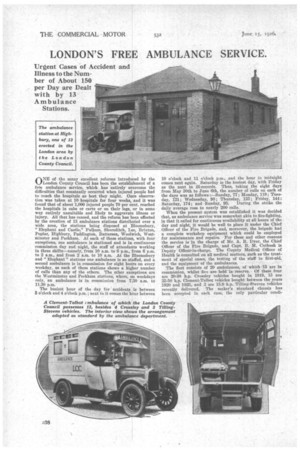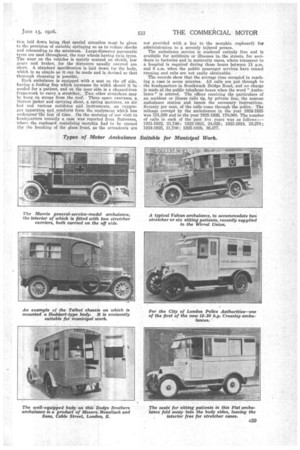LONDON'S FREE AMBULANCE SERVICE.
Page 20

Page 21

If you've noticed an error in this article please click here to report it so we can fix it.
Urgent Cases of Accident and illness to the Number of About 150 per Day are Dealt with by 13 Ambulance Stations.
FINE of the many excellent reforms introduced by the IL/London County Council has been the establishment of a free ambulance service, which has entirely overcome the difficulties that constantly occurred when injured people had to reach the hospitals as best they might. Once observation was taken at 10 hospitals for four weeks, and it was found that of about 1,000 injured people 70 per cent, reached the hospitals in cabs or carts or on their legs, or in some way entirely unsuitable and likely to aggravate illness or injury. .All that has ceased, and the reform has been effected by the creation of 13 ambulance stations distributed over a wide area, the stations being disposed at Bloomsbury, " Elephant and Castle," Fulham, Shoreditch, Lee, Brixton, Poplar, Highbury, Paddington, Battersea, Woolwich, Westminster and Peckham. At each of these stations, with four exceptions, one ambulance is stationed and is in continuous commission day and night, the staff of attendants working in three shifts—namely, from 10 a.m. to 6 p.m., from 6 p.m. to 2 a.m., and from 2 a.m. to 10 a.m. At the Bloomsbury and " Elephant " stations one ambulance is so staffed, and a second ambulance is in commission for eight hours on every weekday, as each of these stations shows a higher number of calls than any of the others. The other exceptions are the Westminster and Peckham stations, where, on weekdays only, an ambulance is in commission from 7.30 a.m. to 11.30 p.m.
The busiest hour of the day for accidents is between 3 o'clock and 4 o'clock p.m.; next to it comes the hour between
10 o'clock and 11 o'clock p.m., and the hour to midnight comes next again. Saturday is the busiest day, with Friday as the next in ill-records. Thus, taking the eight days from May 30th to June 6th, the number of calls on each of the days was as follows :—Sunday, 77; Monday, 119; Tuesday, 121; Wednesday, 98; Thursday, 123; Friday, 144;
Saturday, 174; and Sunday, 95. During the strike the daily average rose to nearly 200 calls. When the present system was established it was decided that, as ambulance servicn was somewhat akin to fire-fighting, in that it called for continuous availability at all hours of the day and night, it would be well to place it under the Chief Officer of the Fire Brigade, and, moreover, the brigade had a complete workshop equipment which could be employed for maintenance and repairs. For these and other reasons the service is in the charge of Mr. A. R. Dyer, the Chief Officer of the Fire Brigade, and Capt. B. M. Cutbush is • Deputy Officer-in-eharge. The County Medical Officer of Health is consulted on all medical Matters, such as the treatment of special cases, the testing of the staff in first-aid, and the equipment of the ambulances. • • The fleet consists of 20 ambulances, of which :15 are in commission, whilst five •are-held. in reserve.. Of these font. are 20-30 h.p. Crossley vehicles bought in 1919, 13 are 25-50 h.p. Clement-Talbot vehicles bought between the years 1920 and 1925, and 3 are 15.9 b:p. Tilling-Stevens vehicles recently delivered. The maker's standard chassis has been accepted in each case, the only particular condi tion laid down being that special attention must be given to the provision of suitable springing so as to reduce shocks and rebounding to the minimum. Large-diameter pneumatic tyres are used throughout, the rear wheels having twin tyres. The wear on the vehicles is mainly centred on clutch, low gears and brakes, for the distances usually covered are short. A standard specification is laid down for the body, which is as simule as it can be made and is devised so that thorough cleansing is possible.
Each ambulance is equipped with a seat on the off side, having a folding flap which increases its width should it be needed for a patient, and on the near side, is a channel-iron framework to carry a stretcher. Two, other stretchers ,may be hung on straps from the roof. Three spare canvases, a Barnes jacket and carrying sheet, a spring mattress, an air bed nod various antidotes and instruments, an oxygengas apparatus and comforts form the equipment which has undergone the test of time. On the morning of our visit to headquarters recently a ease was reported from Battersea, where the cupboard containing morphia had to be opened (by the breaking of the glass front, as the attendants aro not provided with _a key to the morphia cupboard) for administration to a severely injiired person.
The ambulance service is rendered entirely free and is available for accidents or illnesses in. the streets, for accidents in factories and in maternity cases, where transport to a hospital is required during those hours between 11 p.m. and 8 a.m, when the public passenger services have ceased running_and cabs are not easily obtainable.
The records show that the average time occupied in reaching n.etteeis seven minutes. All calls are put through to the headquarters in Southwark Bridge Road, and no charge is made at the public telephone boxes when the word " Ambulance " is uttered. The officer receiving the particulars of an accident or illness calls Up, by private line, the nearest ambulance station and issues the necessary instructions. Seventy per cent. of the calls come through the police. The mileage covered by the ambulances in the year 1924-1925 was 151,300 and in the year 1925-1926, 170,000. The number of calls in each of the' past five years was as follows :— 1921-1922, 21,740; 19224923, 24,626; 1923-1924, 28,270; 1924-1925, 31,700; 1925-1926, 36,477.




















































